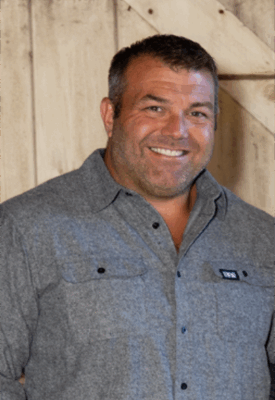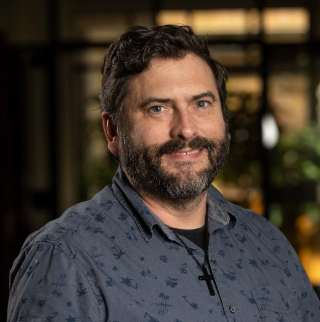Jonathan Schmid
Director of Innovation & Technology
Meadowbrook School of Weston,
Independent K-8 School
MassCUE: So Jonathan, what is one thing that you are really passionate about?
Jonathan: I’m excited about helping students become creators by using technology, and having them use it to express themselves by creating new things and unlocking the excitement that goes along when students surprise themselves.
MassCUE: And how do you do that?
Jonathan: I think there are many different ways we achieve that.  One is simply giving students the time and the space to explore technology. The actual physical devices are sometimes not the most important factor. Just giving them the freedom and permission to explore empowers students to look at technology and the opportunities it offers. As educators, we often offer a limited path of choices, but there’s actually an unlimited array of options. We see students choosing tools in ways we didn’t even think were possible. I love when they surprise you with a really clever way of putting tools together.
One is simply giving students the time and the space to explore technology. The actual physical devices are sometimes not the most important factor. Just giving them the freedom and permission to explore empowers students to look at technology and the opportunities it offers. As educators, we often offer a limited path of choices, but there’s actually an unlimited array of options. We see students choosing tools in ways we didn’t even think were possible. I love when they surprise you with a really clever way of putting tools together.
MassCUE: So speaking of those tools, what are a couple of your favorites?
Jonathan: Google Apps for Education would be my most essential tool, especially Google Drive. The amount of collaboration it unlocks has become such a core part of the way students learn in every subject. Social media, such as Twitter, is really important to me personally and allows me to collaborate with other educators. Social media encourages you to find out what’s going on outside your vantage point and share ideas. Another tool I use a lot is Evernote. It’s a great way to file away information, come back to the notes, and quickly retrieve an idea that I might have recorded a long time ago.
MassCUE: So with social media, do you use that at school with students?
Jonathan: Our school has a digital citizenship curriculum for students for all students, K-8. We used Common Sense Media’s curriculum as a starting point, but adapted and selected lessons that best fit our students and the technology choices we make. The curriculum dove tails with the values and the character that the school promotes. So social media, especially in the middle school, becomes a bigger part of the digital citizenship program and part of what our students experience.
Our school also uses social media to share what’s happening on campus, to communicate to the school community and the world at large about what’s going on. The school has Twitter, Instagram, a YouTube channel, and a Facebook page as well. On a personal level I use especially Twitter, Instagram, and Pinterest to share project ideas and then to find inspiration from other educators and others. We’ve created many projects that start as an idea from another school or educator that we found through social media.
MassCUE: The school Facebook and twitter pages— do you work with the students to actually keep those up?
For school social media, the students will help create content that gets used on those pages. However students don’t actively post to those pages. There’s a faculty advisor that makes the decisions about what gets posted on social media and the different channels For example, we have some classes that create films, and the finished projects will get posted on the YouTube channel. Different social media platforms get handled in different ways. For many of them, it’s a collection of faculty members who have the ability to post that allows a wide array of new content to be shared, not just trapped to one person’s experience. This helps the perspective of social media to be one of the entire school, instead of just one person.
MassCUE: What is a current project you’re working on?
Jonathan: Right now I am working on two big projects. One is helping to coordinate and teach workshops for the Googlepalooza with MassCUE (teacher professional development) and the other is a creating a Makerspace for our students.
We recently named our Makerspace the EurekaLab. It’s a three-year project that started with looking at other schools, finding best practices in STEM, Design Thinking and Project-Based Learning, and experimenting along the way. We are currently working with MIT’s Edgerton Center to integrate Making and the Design Engineering Process into every subject, as well as determining logistics such as selecting tools and creating the space.
We’re also working with the Edgerton Center to create curriculum for Makerspaces in schools that use tools such as 3D printing, laser cutting and vinyl cutting, electronics, as well as low-tech tools like popsicle sticks and pipe cleaners. That project has been a really exciting one as we are exploring the best tools to use, the best way to integrate them into core classes, and the best way to get every student to have an experience that involves hands-on project-based learning approach.
The best part of the EurekaLab is the projects students create.  For instance, we recently participated in a project called PongSat, where an aerospace company sends small student experiments that fit inside of a ping-pong ball to the edge of space. Students take a ping-pong ball, cut it in half, and create an experiment to make the journey to space. They flew about 1,700 ping-pong balls with student work up to the edge of space, with 100 being created by Meadowbrook students. They record and take pictures of the entire process, retrieve the PongSats after they return to Earth, and then they send them back to the students. Our students just received their experiments back, and had so much excitement and a better understanding of the extreme conditions in space.
For instance, we recently participated in a project called PongSat, where an aerospace company sends small student experiments that fit inside of a ping-pong ball to the edge of space. Students take a ping-pong ball, cut it in half, and create an experiment to make the journey to space. They flew about 1,700 ping-pong balls with student work up to the edge of space, with 100 being created by Meadowbrook students. They record and take pictures of the entire process, retrieve the PongSats after they return to Earth, and then they send them back to the students. Our students just received their experiments back, and had so much excitement and a better understanding of the extreme conditions in space.
Another great project that we just finished was with the fifth grade math classes. They used a design thinking process where they thought like designers, interviewing the third-grade math class and teacher to design math manipulatives that would help them as they learn fractions. Students worked in small groups, each designing prototypes, testing those prototypes, seeing what worked and didn’t, and interviewing the students and the teacher again. They ended up using a laser cutter to cut out prototypes first in cardboard. The third-grade teacher is really excited about the custom made manipulatives made for their teaching methods and style, and they’re really excited to use them in the future.
We also created a website for the EurekaLab (eureka-lab.org). I think the title “EurekaLab” is really fitting, because you constantly see students have that light bulb moment where they were working on something they were struggling with and suddenly it all clicks. I think that’s why teachers become educators, to help students construct the understanding and discover new concepts. To use these new tools like 3-D printing and fabrication tools alongside with old tools, it’s just a great time to be in teaching. See Saturday Thing at Meadowbrook. Also see Eureka Lab Blog.
We’ve been working on this project for quite a while. Meadowbrook, as an independent school, has the freedom to take some risks in trying new curriculum and methods. We want to share what we find that works, as well as save others from making our same mistakes. A big part of this project is sharing what we do.
MassCUE: Who do you most admire and why?
I admire Steve Jobs and the vision he had to look at things in a way that no one else had. He was determined to make things happen and realize his vision.  The other person I admire is Elon Musk, the founder of Telsa Motors, SolarCity, and SpaceX. He was also willing to risk everything to start companies focused on making a drastic improvement on society. I think that’s what we need to inspire in our students, by giving them the core skills that they need to survive in the future but also the inner belief in themselves. They need the creativity and the determination to push through adversity and make something happen when they believe in it. And I think both Steve Jobs and Elon Musk both have done that.
The other person I admire is Elon Musk, the founder of Telsa Motors, SolarCity, and SpaceX. He was also willing to risk everything to start companies focused on making a drastic improvement on society. I think that’s what we need to inspire in our students, by giving them the core skills that they need to survive in the future but also the inner belief in themselves. They need the creativity and the determination to push through adversity and make something happen when they believe in it. And I think both Steve Jobs and Elon Musk both have done that.
MassCUE: How do you stay current on trends and new technology? It seems like you’re involved with a lot of great projects. How do you find out about those?
I use social media to follow people doing interesting things in many different areas, like education, startups, and the maker movement. A couple of the projects we’ve worked on started as a Kickstarter project. Another way to find interesting projects is to look at trends and ideas gaining momentum there, and ask ourselves how our students could work in those areas.
For example, the PongSat project started as a Kickstarter project. I noticed the project, and emailed the creator, asking if we could run a contest to send just one ping-pong ball to space. I was surprised when the creator emailed me back and said they had space for a hundred!
Often those ideas are more general technology/startup related, and the trick becomes finding what applies to our students, taking these trends that are happening in technology as a whole, and finding the ways that apply to our students at an appropriate level.
Even on YouTube there are so many great ideas. There are so many people who consistently put out great videos around Makerspaces and making. While they’re not for specifically designed for educators, they have so many ideas that would be a great fit in so many subject areas. To see more ideas that Meadowbrook has done, check out Ancient Mesopotamia and the Pause & Think Online Contest.
Conferences are also a great source of information. I love attending and presenting at conferences, just talking to people and seeing what they’re excited about. When you share the things you learned, you just naturally end up getting information back as well. It creates a cycle of sharing and receiving information that’s particularly powerful.
 Print this post
Print this post



